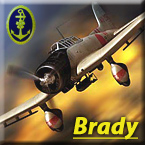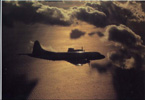ChezDaJez
Posts: 3436
Joined: 11/12/2004
From: Chehalis, WA
Status: offline

|
quote:
But it was striking to me that the logs Brady posted described recon missions only, and not once reported that a Glen spotted such-and-such vessel in the open sea. Sure, that doesn't mean that Glens weren't used in the air-search role -- but it might well suggest that Glens weren't very effective in that role. Why would the logs tell us the Glen spotted a vessel in such-and-such harbor but would omit telling us about the Glen sotting a vessel in the open sea?
Hi, Grotius,
I-10 sank several ships during its patrols. I think its fair to assume that some of those may have been initially located by its Glenn. The TROM is too limited in detail to verify whether this is true or not. I used to have a book on Japanese sub operations but I haven't been able to find it in years. Guess I'll have to find another one that may detail how the Glenn was used in the scouting role. But that is what the entire aircraft-carrying sub concept was designed for... to scout ahead of the fleet and to locate targets for itself.
As someone pointed out, its not the search capability of the Glenn that should be questioned. Its the way WitP conducts air searches in general. Its basically a range circle around a base and everything inside it is subject to detection even though there may only be one search aircraft available.
True air searches consisted of searching sectors the size of which depended upon the furthest range to be searched and the number of available aircraft. The primary search emphasis would be towards the perceived threat axis. It would be nice in WitP II takes this into account. Basically it would require the ability to input a threat axis. For example, if you are expecting the enemy to make a move from a base to your north, you would tell the computer to focus the search to the north. The resulting search plan would resemble a cardioid pattern.
Chez
_____________________________
Ret Navy AWCS (1972-1998)
VP-5, Jacksonville, Fl 1973-78
ASW Ops Center, Rota, Spain 1978-81
VP-40, Mt View, Ca 1981-87
Patrol Wing 10, Mt View, CA 1987-90
ASW Ops Center, Adak, Ak 1990-92
NRD Seattle 1992-96
VP-46, Whidbey Isl, Wa 1996-98
|
 Printable Version
Printable Version










 . No one has mentioned that if you play a game with Player Defined Upgrades you can change the Glens to Alfs to extend the sub-based search range to 7 hexes. Careful placing of the subs at key places gives a pretty complete picture of what's coming and going. In fact, I make the changes to the search planes on all ships (CAs and BBs).
. No one has mentioned that if you play a game with Player Defined Upgrades you can change the Glens to Alfs to extend the sub-based search range to 7 hexes. Careful placing of the subs at key places gives a pretty complete picture of what's coming and going. In fact, I make the changes to the search planes on all ships (CAs and BBs). 




 New Messages
New Messages No New Messages
No New Messages Hot Topic w/ New Messages
Hot Topic w/ New Messages Hot Topic w/o New Messages
Hot Topic w/o New Messages Locked w/ New Messages
Locked w/ New Messages Locked w/o New Messages
Locked w/o New Messages Post New Thread
Post New Thread